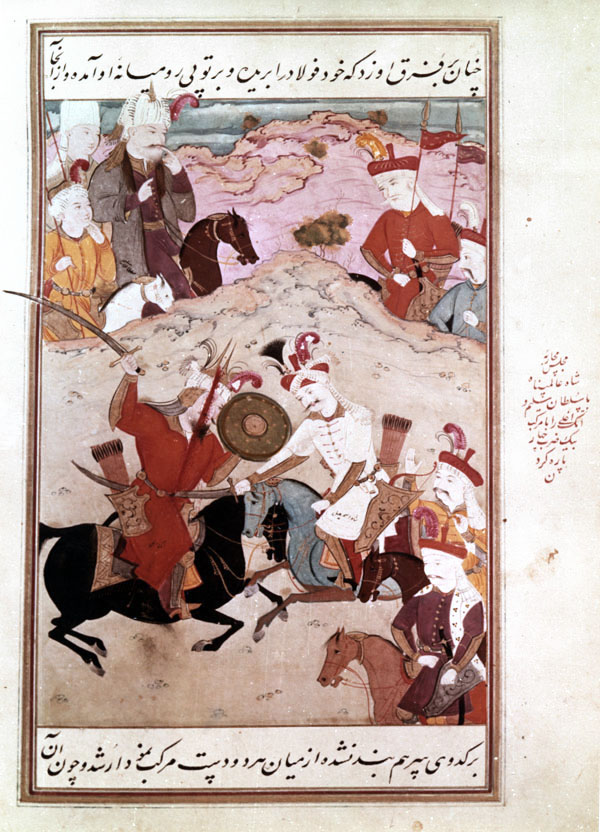Manuscripts
tāriḵ-e ʿālām-ārā-ye šāh esmāʿil
Cf. manuscript L, folio 249, for another version of this painting, and for a summary of the event. The date is 2 Rajab 920/23 August 1514, the place is Čalderān, and the event is the battle between the Safavids and Ottomans. The principal combatants depicted in the painting are Shah Esmāʿil on the right, and Malqoč-oḡli, called Ankoḡli in the text, on the left. The two contestants occupy center stage and are portrayed the moment after Esmāʿil’s sword had struck. Lunging forward, the shah has brought his heavy sword down cleaving Ankoḡli from helmet tip to navel. He has been effectively split in two vertically and blood gushes out, yet the blow was delivered so instantaneously that Ankoḡli still remains upright in the saddle, sword and shield raised high. Sultan Selim, in a sign of astonishment, and the Ottoman forces as represented by two standard bearers, observe the battle from behind a ridge in the upper left. The Safavid forces consist of four horsemen, two in the right foreground, and two others behind a ridge in the upper right. Only the two contestants are involved in battle; the others seem content to simply observe.
Shāh Esmāʿil wears the same gold trimmed white knee-length coat and red and white flat top qezelbāš tāj encountered on previous folios. An encased bow and quiver case with arrows hangs from his belt, and he rides a blue-gray charger muddied up to its belly. Ankoḡli (Malqoč-oḡli), atop a black horse, is dressed in vermillion and a pointed helmet, while Sultan Selim wears a purple robe decorated with gold, a gray topcoat, and tall white Ottoman headgear; only the head and neck of his brown horse are visible. The clothing of his accompanying standard bearer is bright yellow-orange. All four Safavids wear the flat top red and white tāj similar to Esmāʿil’s, and are dressed in vermillion, blue, yellow, and purple respectively.

The backdrop is austere: a flat neutral ground rises to a ridge tinted with brown about two-thirds of the way up from the bottom. Behind this is a secondary ridge executed in light mauve, and at the top a narrow band of cloudy blue sky. Only the slightest suggestion of vegetation exists in the entire picture.
Compositionally this painting has been simplified and portrays fewer figures than the British Library variant cited above. Otherwise the compositions are organized in essentially the same manner. From a draftsmanship point of view, the linework in the British Library version is more fluid and suggestive of a sketch technique, while this version is more polished and finished. These qualities add support the view that the British Library version is the earlier of the two in date.
Painting: 19.2 x 14.0 cm. One line of text above and below the painting. Frame encloses painting and text; only the tip of Ankoḡli’s sword protrudes beyond the frame into the margin. Some smearing below the belly of Ankoḡli’s horse, but no other signs of damage or retouching. A marginal inscription in red, presumably of later date, describes the event depicted. Inscriptions in black appear on three of the figures, identifying them as Shāh Esmāʿil, Sultan Selim, and Ankoḡli.
Painting references:
Mahboubian_1972, #923 folio 298v (not ill.).
Text X-references:
See Muntaẓer-Ṣāḥeb_1970, pp.521-22 for this event in the History of Shah Esmāʿil.
See Savory, SA_1979, p.69 for this event in the History of Shah ʿĀbbās.
Robert Eng
Last Updated: December 16, 2010
Originally published: April 4, 2002